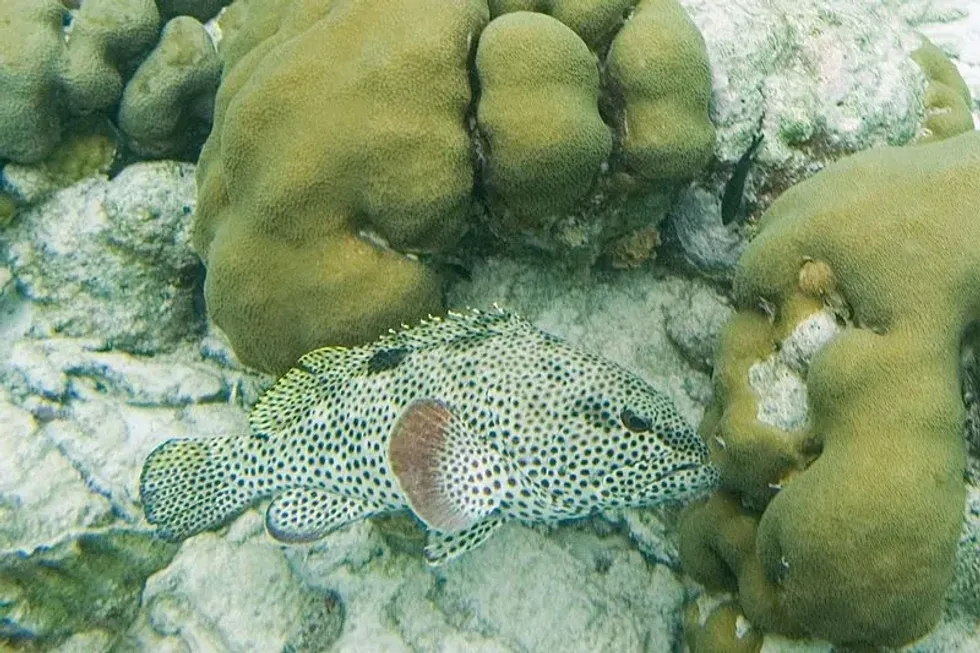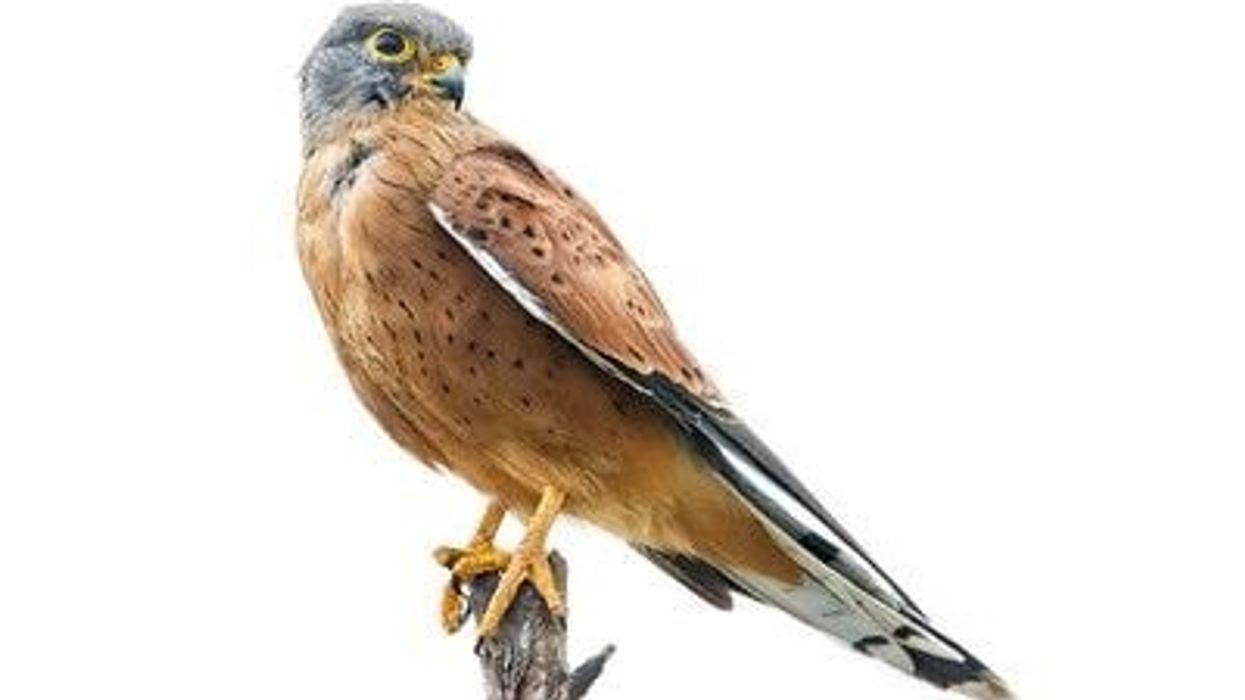The Rock Hind, Epinephelus adscensionis, is a solitary fish that belongs to the genus Epinephelus. It is commonly referred to as Cod, Rock Grouper, Trout, Rock Cod, Deady, Grasby, and Butterfish.
These fish can also be known as 'hinds' just like all other fish of the same genus.
This distinct fish has brown spots all over its pale body, including its tail and fins over a tan-olive-brown base. The Rock Hind is 2 ft (60 cm) in length on average.
The Rock Hind is frequently mistaken for the Red Hind, (Epinephelus guttatus), but the Red Hind is smaller and the tail has a black margin with no spots. These fish are carnivorous and their diet consists of crabs and fish.
These distinct fish can be found in Western Atlantic from Massachusetts to Brazil covering the Eastern Caribbean, Bahamas, Bermuda, the north part of the Gulf of Mexico, and Florida.
What's fascinating and unusual about these fish is that they are hermaphrodites, which means they can change their sex! Keep on reading to know about the appearance, distribution, diet, and much more about this distinguished fish in detail!
If you enjoy reading our Rock Hind facts, then you will surely enjoy reading about the spiny dogfish and catfish as well.
Rock Hind Interesting Facts
What type of animal is a Rock Hind?
The Rock Hind, Epinephelus adscensionis, is a fish of medium size that weighs a whopping 987.5 lb (447.9 kg) on average! These hinds range in length from 1.9-2.1 ft (58-66 cm) and have an average length of 2 ft (60 cm).
What class of animal does a Rock Hind belong to?
The Rock Hind fish belongs to the class Actinopterygii and order Perciformes. The Rock Hind can also be called a Ray-finned fish because it is a member of this class. Ray-finned fishes are named so because their fins are webs of flesh supported by bony spines.
How many Rock Hinds are there in the world?
The population of Rock Hind, Epinephelus adscensionis, is unknown. But we do know that they are widespread across the world occurring in shallow as well as deep reefs.
Where does a Rock Hind live?
These hinds are commonly spotted in shallow waters as well as floating near the ocean's base. They are found in the western Atlantic from Massachusetts to the South of Brazil covering the Eastern Caribbean, Bahamas, Bermuda, and the northern part of the Gulf of Mexico. They are scarce in Florida.
What is a Rock Hind's habitat?
Their habitat range includes rocky inshore areas as well as deep reefs. This species of fish can be found in the western tropical and subtropical Pacific Ocean at depths of 6.5–131 ft (2–40 m).
Who does Rock Hind live with?
The Rock hind is a solitary fish, that lives with its mate only during the breeding season.
How long does a Rock Hind live?
They can live on average for 12 years. But it can live as long as 50 years.
How do they reproduce?
This hind fish can migrate more than 30 km from their home areas to breeding grounds. The species releases eggs in pairs that form inside single-male/or multiple-female groups. The females lay on or near the bottom, whilst males roam about near the area where the females are. The male fish defends this area from other male hinds.
What is their conservation status?
Their population trend is decreasing but their conservation status is Least Concern as per the IUCN's Red List.
Rock Hind Fun Facts
What do Rock Hinds look like?
The appearance of Rock Hinds and Red Hinds is similar. The Rock Hind has dark brown spots all over its body, tail, and fins. Its anal fins as well as its tail have wide white borders rather than the black edges found in Red Hinds. The Rock Hind fish may change, going pale or darker.
How cute are they?
The Rock Hind has a distinct pattern that differentiates them. These pale groupers can be appealing to some but for people who have Trypophobia (fear of many dots), it can cause feelings of disgust as well as fear!
How do they communicate?
These solitary species make low-frequency noises for courting and spawning by vibrating their axial muscles against their swim bladders.
How big is a Rock Hind?
The Rock Hind grouper is quite long and has a length anywhere in the range of 23- 26 in (58-66 cm). They can grow up to 2.1 ft in length! They are almost five times the length of catfish.
How fast can a Rock Hind move?
The Rock Hind fish can be found in the ocean at depth levels of 6.5–131 ft (2–40 m). The speed with which they swim is unknown.
How much does a Rock Hind weigh?
The Rock Hind is a significantly heavy fish weighing anywhere in the range of 975-1000 lb (442-453 kg)!
What are the male and female names of the species?
There is no significant name for the male or female fish of this species.
What would you call a baby Rock Hind?
The young of the Rock Hind fish can be called fry.
What do they eat?
Their diet consists of crabs, shrimp, and fish. They eat crabs mainly though. They look for their prey near the base of the ocean.
Their prey is swallowed completely and is held firmly by many pointed teeth that surround the tongue, jaw, and roof of the mouth. Their main predators are sharks, namely the Silk shark, Tiger shark, and Caribbean Reef shark. They are also eaten by Yellowfin grouper and King Mackerel.
Are they poisonous?
These groupers contain poisonous chemicals generated by dinoflagellates that bioaccumulate and can cause ciguatera, a rare deadly form of poisoning when swallowed. There have been reports of ciguatera poisoning which is a threat.
Would they make a good pet?
No, these groupers won't make very good pets as they would require huge enclosures to handle their bulky bodies. They are introverts and avoid engaging with humans. There haven't been any known instances of these fish kept as pets.
Did you know...
All Rock Hinds are born as females! Some change their sex to males later on as they are hermaphrodites.
Do they bite?
A fish biting means that it is responding to the angler's line or is caught in it. To tempt these pale groupers, the angler uses a very sturdy hook and line that is resistant to its strong jaws.
It's a tough fight when the groupers bite. These groupers are infamous for getting an angler's line caught in rocks. When a bite is felt, it is usually because the line has been entangled by the grouper.
When a large grouper gets caught, it is grasped by its gill covers since they are spiky and rough. Groupers have a great deal of power.
Do humans eat them?
Yes, all the species of the genus Epinephelus are suitable to be eaten. They are in demand by sport fishermen.
Here at Kidadl, we have carefully created lots of interesting family-friendly animal facts for everyone to discover! Learn more about some other fish from our swai fish interesting facts and skate fish facts for kids.
You can even occupy yourself at home by coloring in one of our free printable Rock Hind coloring pages.










